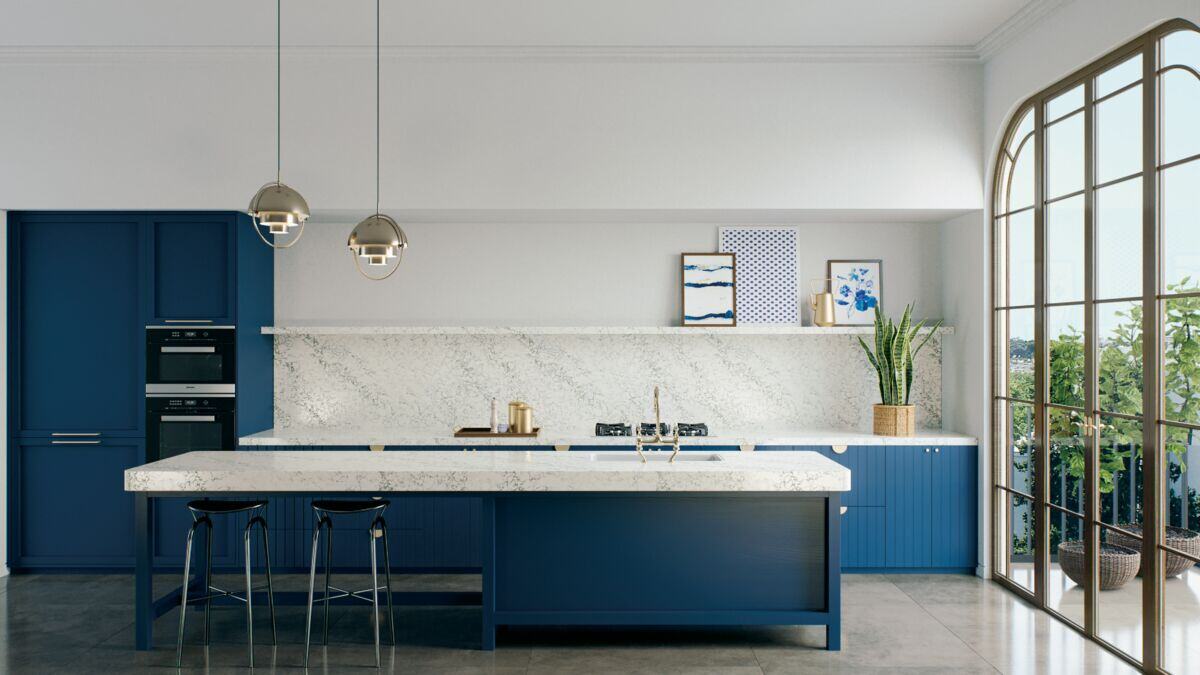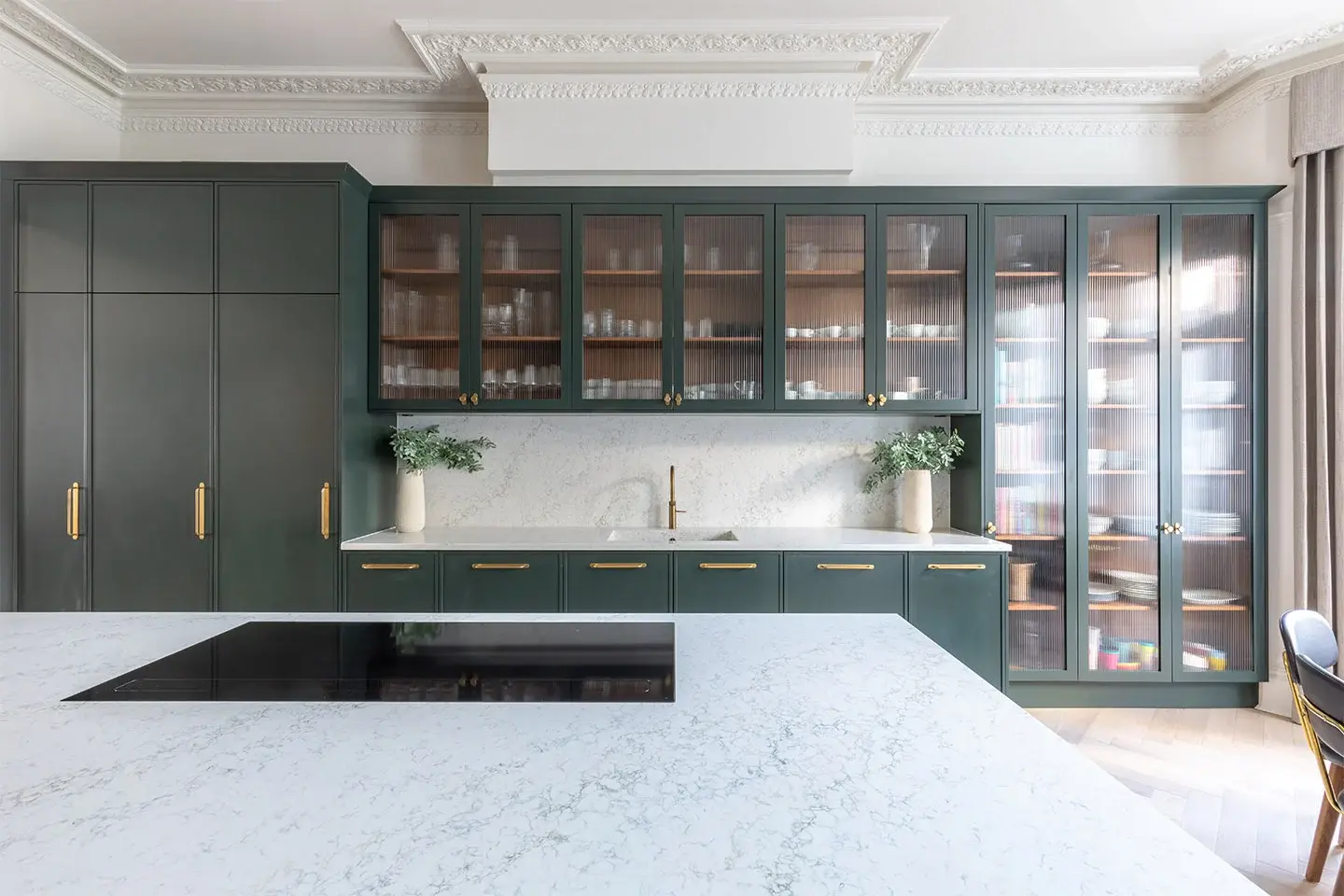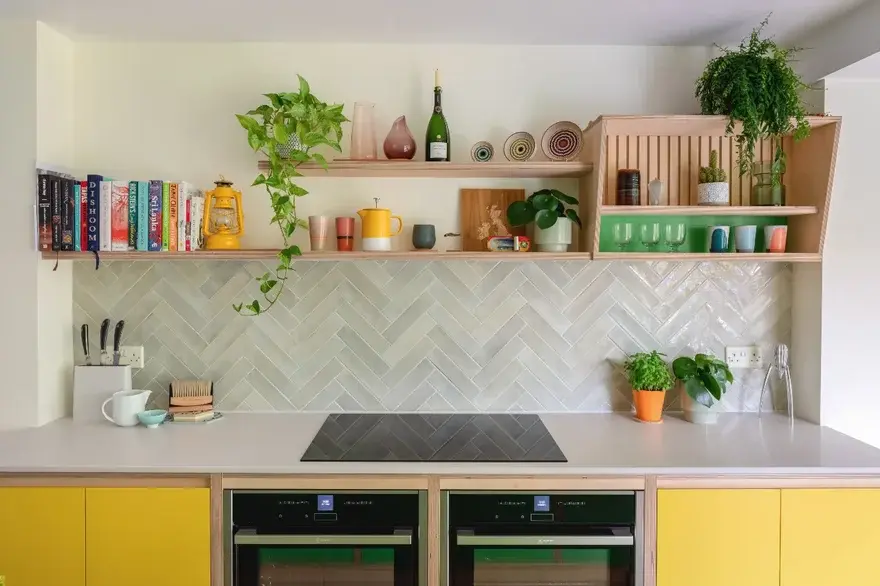
Selecting the perfect Caesarstone worktop involves more than just choosing a colour or pattern. There are several factors - from batch variance and finish of your surface to installation considerations and how you light your project - that can influence how your worktop will ultimately look in your kitchen. Understanding these elements can help ensure that your chosen surface seamlessly integrates with your space and meets your design expectations.
Manufacturing considerations
Your worktop’s finish
The finish of a Caesarstone surface plays a significant role in how it appears once it’s been installed in your home – just like how the same paint colour in matte looks different in silk.
When talking about worktops, polished finishes reflect more light, which can enhance the surface’s brightness but you may wish to take care not to overlight the surface. Matte finishes however, such as honed, concrete, rough or ultra-rough, offer a more subdued sheen, diffusing light and creating a softer aesthetic.
Batch variance
Caesarstone surfaces are crafted to deliver consistent quality, but as these are formed from natural materials, there can be slight variations between one production batch and the next. This means that the base tone of a worktop may differ subtly from smaller samples or still swatch images.
When choosing your surface, we advise making sure all elements are agreed with your designer and/or fabricator, including any drop-down ends, upstands, splashbacks as well as any finishing touches you’d like in the same surface, such as window sills or open shelving. This means not only that enough material is ordered but also that you can make sure all your surfaces come from the same batch to minimise any colour variance once your project is completed.
Installation considerations
While the manufacturing process obviously has a great impact on the appearance of your new worktops, the installation also plays a part in their final look, from the size of the surface through to surrounding materials and how they’re lit.
Size matters
Caesarstone worktops are usually one of the most reflective surfaces in a kitchen – this means that the more worktop area there is, the more it will contribute to the room’s brightness. In open-plan or light-filled spaces, a large expanse of a polished surface can reflect and enhance whatever light there is (whether natural or artificial), while a matte finish offers a more understated look.
Surrounding materials
The various other materials around the kitchen, such as tiles, paint, cabinet doors, handles and taps, can all subtly change the perception of the Caesarstone worktop once it’s in situ, highlighting and emphasising certain subtle pigments of the surface.
For example, the veining in 5171 Arabetto - a dynamic veined white polished mineral worktop with subtle pigments interspersed in its dynamic marble motif - can take on different tones depending on the colour scheme of the kitchen. In a blue kitchen, the grey and blue hues within the worktop will be made more prominent, while in a space with more green tones, the jade undertones will become more noticeable.
 5171 Arabetto in a bright kitchen paired with blue cabinets.
5171 Arabetto in a bright kitchen paired with blue cabinets.
To help you find the best match for your kitchen, we encourage you to compare your Caesarstone sample against paint swatches and different cabinet styles in both natural and artificial lighting at different points of the day. We also invite you to visit one of our studios where you can see our worktops in a highly tactile and immersive experience; our studios have a huge range of luxury paint cards, wood and tile samples so you can see how everything works together.
The role of lighting
Lighting is one of the most influential factors in how a Caesarstone worktop looks once it’s been installed, and the power of lighting goes beyond mere brightness.
The effect of light temperature
The “temperature” of the light can have a major impact on the worktop’s appearance, as well as the whole mood of the space. Warmer light sources, typically in the range of 2700K–3000K, create a more inviting and cosy atmosphere, bringing out warmer tones in the worktop (and other materials). On the other hand, cooler light sources (4000K and above) can make a space appear more stark or sterile, often emphasising the cooler pigments within a worktop. Natural daylight, which exceeds 5000K, has a bluish tint that can also influence how colours are perceived.
 6131 Bianco Drift in a kitchen with cool overhead lights and natural daylight
6131 Bianco Drift in a kitchen with cool overhead lights and natural daylight
Colour rendering and accuracy
As well as temperature, the ability of a light source to accurately represent colours, known as Colour Rendering Index (CRI), plays an important role. Natural daylight provides the most accurate colour representation, while artificial lighting varies in quality. Lower CRI lighting may distort the “true” colour of a worktop, which is why we recommend checking samples in both daylight and artificial light settings.
Light angles and reflection
Horizontal surfaces, such as worktops, are typically illuminated by overhead task lighting, while vertical surfaces, such as splashbacks or waterfall edges, will naturally receive different levels of light which may cause the surfaces to appear differently. If you are considering expansive vertical surfaces in your space, it would be beneficial to see how a sample of your preferred surface reacts to light on both planes. To maintain consistency, it is best to use slabs from the same batch when combining horizontal and vertical applications as this helps ensure a seamless visual flow throughout the kitchen.
You may wish to think about the overall light levels in your project; over-lighting a polished worktop can increase the brightness of your space as it reflects light throughout the room, but it may also cause subtle details to appear washed out under intense lighting.
Proper care and maintenance
Caesarstone surfaces, designed and known for their longevity and easy cleaning, don’t need sealers or colour enhancers, which are often used on natural stone products. Using these products on a Caesarstone worktop can alter its appearance and even impact its performance. As well as avoiding these sealers and enhancers, we recommend you follow our simple care and maintenance tips so as not to risk discolouration.
How Caesarstone can support you
At Caesarstone, we’re committed to helping our customers make informed decisions. This means our experts can provide guidance on colour choices, batch consistency and lighting considerations so you can be sure that your chosen worktop is as you expect it to be.
We also encourage you to request a sample and visit one of our studios, where you can see full worktop slabs alongside leading cabinetry and paint brands, and experience how different lighting conditions affect the material’s appearance. Our team is here to support you every step of the way, ensuring you choose a worktop that perfectly complements your space.

.jpg)
